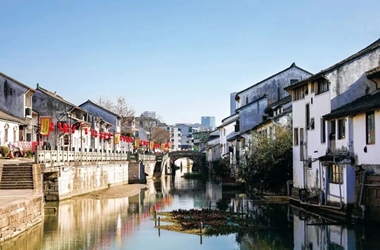Encounter Xixing Ancient Town While Roaming

Take the subway to "Xixing Station" on Line 1, turn a few corners and walk 500 meters, and you will see this ancient town with a thousand years of history - Xixing Ancient Town.
It used to be an important gateway of Eastern and Western Zhejiang in the past, with rich cultural heritage and numerous historical sites. It is the source of the Eastern Zhejiang Ancient Canal. Xixing Old Street has been listed as one of the top ten historical and cultural protected areas in Hangzhou and is currently the most well-preserved old street in the city. The old street is 960 meters long, stretching from Tielingguan in the west to Zifu Bridge in the east. The walking route is very simple.
Route 1:
Follow Guanhe Road and continue along the river to see the original appearance of Xixing Ancient Town.
Guanhe River was born with the excavation of the Eastern Zhejiang Ancient Canal and is the local term for the ancient canal in Xixing. Walking on Guanhe Road, you will see a square area surrounded by wooden fences, and there is a wooden sign next to it, recording its story. This used to be a water gate called Yongxing Lock.
The lock was located at the entrance of Xixing Ancient Canal, also known as Longkou Lock. It connected the Qiantang River and the Eastern Zhejiang Ancient Canal. In the 15th year of the Wanli reign of the Ming Dynasty (1587), Liu Hui, the county mayor of Xiaoshan County at that time, used the surplus silver coins from the Xixing embankment project to replace the weir with a lock, in order to drain the water from various villages.
In addition to historical sites, the quaint stone-paved streets, well-arranged residential houses, and fresh air unique to the old street make it a delightful place to linger.
Route 2:
Walk along Xixing Street.
The old street is set along the river, with the north bank as "Guanhe Road," also known as "Lower Main Street," and the south bank as "Xixing Street," also known as "Upper Main Street."
From architecture dating back to the late Qing Dynasty and early Republican era, old-style barber shops, stool shops, and tea houses to the thousand-year-old Xixing lanterns, this place still retains the appearance of the Ming and Qing eras. It is like you can still hear the bustling sounds of the past.
After strolling through the old street, you can also visit the Guotanghang Wharf. The Guotanghang Wharf in Xixing is a transportation hub connecting the Qiantang River and the Eastern Zhejiang Ancient Canal. Since the Western Jin Dynasty, a transit wharf has formed in Xixing, and the area around it quickly developed into a thriving commercial town. The postal stations also shifted their focus to water transport.
The Guotanghang Wharf tells half of Xixing's history. In the exhibition hall of Guotanghang Wharf, you can learn about the splendid history of the Eastern Zhejiang Ancient Canal and the starting point of the Tang poetry route, and the rise and fall of the Guotanghang industry.
Recommended historical sites to visit:
Ancient Zifu Bridge, Wuzi Bridge, Yongxing Lock, Zhuangting Historical Site (Xishi Pavilion), Tielingguan Ruins, ancient stone archway, ancient gate, and Hebutou